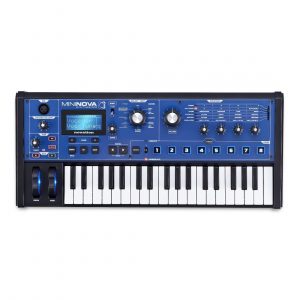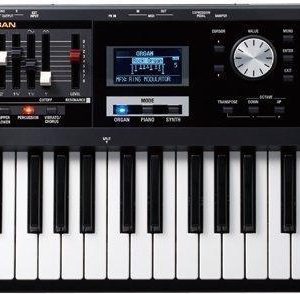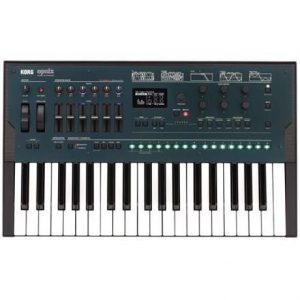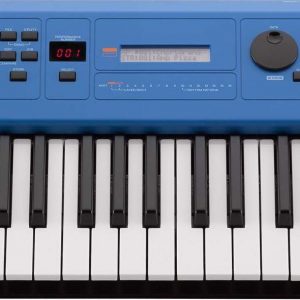Yamaha Reface CS
$266.99
Unleash your creativity with the Yamaha Reface CS – an ultra-portable, feature-packed synthesizer that lets you create the music of your dreams!
Compare
Description
Yamaha Reface CS Synthesizer: A Compact Wonder for Synth Lovers
Yamaha has been in the business of producing high-quality synthesizers for decades. They have consistently set the bar when it comes to offering synthesizers with cutting-edge features and innovative design. The Yamaha Reface CS Synthesizer is another example of their pursuit of excellence. It is a compact and portable synthesizer that comes with a rich selection of sounds, intuitive controls, and advanced features. This synthesizer is tailored towards musicians, producers, and sound designers who value high-quality sound, inspiring creativity, and portability.
Design and Features
The Yamaha Reface CS Synthesizer is designed to deliver a classic analog synthesizer experience, but in a compact and portable package. It weighs only 4.2 lbs and measures 2.1 inches by 22.21 inches by 6.6 inches, making it easy to take on the road, to the studio, or anywhere you need to make music. Despite its small size, it has a sturdy build and feels durable.
The Reface CS comes with a 37-mini key keyboard that is touch-sensitive and can be played with two hands. The keys are slightly smaller than the keys on a standard keyboard but are comfortable to play. It also features a hold button and pitch bend and modulation sliders that can add expressive performances to your playing. The synthesizer can be powered by using the included AC adapter, or it can be powered by batteries, making it truly portable.
The Yamaha Reface CS Synthesizer provides ample sound palettes to choose from, including fat and punchy basses, vibrant leads, and atmospheric pads. It also has a noise-generator, which can be used to create various percussive and ambient sounds. To further shape the sound, there are five effects available: distortion, chorus, phaser, delay, and reverb. The effects can be used simultaneously and can be tweaked to your liking.
The heart of the Reface CS Synthesizer lies in its sound engine, which is inspired by the legendary CS-series synthesizers from Yamaha. It uses analog modeling technology to recreate the sounds of some of the most iconic synthesizers in history. The engine is capable of producing fat, warm, and rich analog sounds that are perfect for various genres of music.
Performance
Playing the Reface CS Synthesizer is a joy. The mini-keys have a satisfying feel, and the touch-sensitivity is excellent. The synthesizer is very responsive and allows for expressive performances. The interface is well laid out and easy to navigate, with dedicated knobs for various parameters. This makes it easy to create sounds from scratch and to tweak existing sounds to your liking.
The synthesizer also has a sequence looper that allows for recording up to 16 steps. You can use this to create complex patterns, arpeggios, and more. The looper is easy to use and can be synced to external devices using the MIDI out port.
Conclusion
In conclusion, the Yamaha Reface CS Synthesizer is an excellent choice for musicians, producers, and sound designers who need a portable, compact, and versatile synthesizer. It is designed to deliver inspiring sound, intuitive controls, and advanced features that make it a joy to play. The synthesizer is suitable for various genres of music, from electronic dance music to ambient and everything in between. It is also easy to use and can be learned quickly, making it perfect for beginners and professionals alike. If you’re in the market for an analog modeling synthesizer that can deliver high-quality sound and portability, then the Yamaha Reface CS Synthesizer is an excellent choice.
Yamaha Reface CS properties
| Product name |
Yamaha Reface CS |
| Brand |
Yamaha |
| Type |
Synthesizers |
| Keys |
Yes |
| Number of Keys |
37 pcs |
| Drawbars/Sliders |
Yes |
| Modulation Wheel |
Yes |
| Pre-Programmed Rythms |
Yes |
| Pre-Programmed Songs |
Yes |
| Pre-Programmed Sounds |
Yes |
| Pre-Programmed Drumset |
Yes |
| Pre-Programmed Effects |
Yes |
| Built-In Tuner |
Yes |
| Portable |
Yes |
| Speakers |
Yes |
| Connections |
3.5mm (AUX), Headphone, Keyboard Pedal, MIDI, Microphone, USB, XLR |
| Colour |
White |
| Power Supply |
Electrical Cable to Wall Socket, USB |
Frequently Asked Questions:
Can you explain how I can create and save my own patches on the Yamaha Reface CS?
Creating and saving your own patches on the Yamaha Reface CS involves two main steps: editing the current patch and storing it. Here's a step-by-step guide to help you:
1. Editing a patch:
- Press and hold both "Function" buttons (FUNC 1 & FUNC 2) while turning on your Reface CS. This will enter the "Patch Edit Mode".
- Use the data dial to navigate through different parameters such as oscillator type, filter cutoff, envelope settings, LFO rate/depth, etc., depending upon the current mode you're in (Poly Mode or Mono Mode).
- Make any changes you wish by pressing the corresponding button or using the data dial.
2. Saving a patch:
- Once you have finished editing your patch, press and hold both "Function" buttons again until the screen reads "SAVE".
- Press FUNC 1 or FUNC 2 to select one of the 8 user locations (A1 through A8). You can also save it as a System Patch by pressing BOTH FUNC 1 & FUNC 2 at the same time.
- When you see the "SAVE" message on the screen, press and hold both data dials until you see "YES". Release them when you're ready to save your patch.
- Your patch is now saved in the selected location. You can verify this by turning off your Reface CS and turning it back on again. When you enter Patch Edit Mode, you should see your newly created patch listed among the other user patches.
Remember that you need to turn off the instrument completely before saving a patch. If you only switch between banks (e.g., from A to B), unsaved changes will be lost.
How does the Yamaha Reface CS's Super Wave synthesis engine compare and contrast to that found in its predecessor, the CS-15D?
The Yamaha Reface CS's Super Wave synthesis engine is a significant improvement over that of its predecessor, the CS-15D. While both synths utilize Yamaha's proprietary FM (Frequency Modulation) technology, the CS's Super Wave engine offers expanded capabilities and functionality. Firstly, the Super Wave engine provides access to a vast library of over 2,000 preset waveforms, which can be combined and manipulated using the synth's FM algorithms. This compares favorably to the CS-15D's relatively limited selection of waveforms. Secondly, the Super Wave engine in the Reface CS offers more advanced modulation options, including ring modulation, amplitude modulation, frequency modulation, and ring envelope generators. These features allow for a greater range of tonal variation and expressivity. Thirdly, the Super Wave engine includes Yamaha's acclaimed Virtual Circuitry Modeling (VCM) technology, which replicates the sound and behavior of classic analog circuitry. This is in contrast to the CS-15D, which does not have this feature. Overall, the Super Wave synthesis engine in the Yamaha Reface CS represents a significant upgrade over its predecessor, providing expanded waveform libraries, advanced modulation options, and VCM technology for richer, more expressive sounds.
How can I optimize the sound capabilities of the Yamaha Reface CS synthesizer to achieve rich and complex textures?
To optimize the sound capabilities of the Yamaha Reface CS synthesizer and achieve rich and complex textures, you should follow these steps:
1. Utilize the FM (Frequency Modulation) synthesis technique: The Yamaha Reface CS synthesizer uses Yamaha's proprietary FM (Frequency Modulation) synthesis technology, which allows for the creation of complex and rich sounds. To take full advantage of this feature, select an FM voice from the preset library or create your own custom voice using the Voice Edit function. Experiment with the modulation matrix: The Yamaha Reface CS synthesizer has a modulation matrix that allows you to route various parameters to control other parameters. This can be used to add movement and variation to your sounds, creating more complex textures. Try routing the Envelope Generator (EG) outputs to different destinations, such as Filter Cutoff or Oscillator Pitch, to create interesting modulation effects. Use the built-in effects: The Yamaha Reface CS synthesizer has a variety of built-in effects, including reverb, delay, and chorus. These effects can be used to add depth and richness to your sounds. Try layering different voices with effects to create complex textures. Utilize the arpeggiator: The Yamaha Reface CS synthesizer has a built-in arpeggiator that allows you to generate complex rhythmic patterns from a single note or chord. Use this feature to add movement and variation to your sounds, creating more complex textures. Try experimenting with different arpeggiator modes and rhythms to find what works best for your desired sound. Layer multiple voices: The Yamaha Reface CS synthesizer allows you to layer up to four voices at once. By layering different sounds, you can create rich and complex textures that would be difficult to achieve with a single voice. Try experimenting with different voice combinations to find what works best for your desired sound. Remember to always perform the task to the best of your ability by being patient, practicing regularly, and staying persistent in your efforts to learn and improve your skills with the Yamaha Reface CS synthesizer.
What are the key differences between the Analog Modeling and FM synthesis algorithms implemented in the Yamaha Reface CS, and how do they affect sound creation and editing?
Analog Modeling and Frequency Modulation (FM) Synthesis. Both of these algorithms are powerful tools for creating a wide range of sounds, from simple tones to complex textures. Analog Modeling, in the context of the Reface CS, refers to the use of digital signal processing techniques to emulate the behavior of analog circuits. In other words, it's a digital simulation of an analog synth. The Analog Modeling algorithm in the Reface CS uses a combination of wave shaping and filtering to create a rich, warm sound that's reminiscent of classic analog synths. FM Synthesis, on the other hand, is a more exotic technique developed by John Chowning in the 1970s. It involves generating sound waves through the interaction of two or more modulating frequencies. The Reface CS's FM algorithm uses a combination of operators and indices to create a wide range of timbres. Now, let's dive into some key differences between Analog Modeling and FM Synthesis on the Reface CS:
1. Sound Generation:** Analog Modeling generates sound through wave shaping and filtering, whereas FM Synthesis generates sound through frequency modulation. Timbre Control:** Analog Modeling offers more straightforward control over timbre, with knobs for cutoff, resonance, and waveshape. FM Synthesis, on the other hand, requires a deeper understanding of operator relationships and index values to shape the sound. Sound Spectrum:** Analog Modeling tends to produce a smoother, more linear spectrum, whereas FM Synthesis can create a wide range of unusual spectral shapes due to the interaction between modulating frequencies. Dynamic Range:** Analog Modeling generally offers a wider dynamic range than FM Synthesis, allowing for more nuanced and expressive playing. Editing Experience:** Analog Modeling is often easier to navigate, with a more intuitive layout and clear associations between knobs and parameters. FM Synthesis, while rewarding once mastered, can be more challenging to edit due to the complex relationships between operators. In terms of sound creation and editing, these differences affect how you approach each algorithm:
* **Analog Modeling:** For creating rich, analog-inspired sounds, focus on adjusting wave shape, cutoff, and resonance to create a wide range of tones. Experiment with different filter types (e. FM Synthesis:** For creating more exotic, texture-based sounds, focus on adjusting operator relationships, index values, and modulation amounts to shape the sound's spectral characteristics. Experiment with different routing schemes and modulation sources to create unique interactions.
What are the specific differences between the Yamaha Reface CS's FM synthesis engine and the original DX7, and how does this impact its sound generation capabilities?
The Yamaha Reface CS is a synthesizer that utilizes Yamaha's proprietary FM (Frequency Modulation) synthesis engine. While it shares some similarities with the original DX7, there are several key differences between the two. One of the main differences lies in the architecture of the engines. The original DX7 uses a 6-operator FM model, whereas the Reface CS employs a more modern 8-operator FM design. This additional operator allows for greater flexibility and expressiveness in sound creation. Another significant difference is in the modulation routings and algorithms employed by each engine. The DX7's 6-operator FM model relies heavily on simple linear FM modulation, whereas the Reface CS introduces more advanced non-linear FM techniques such as ring modulation and frequency shifting. These additional modulation options greatly expand the range of sonic possibilities available to the user. In terms of sound generation capabilities, these architectural differences significantly impact the Reface CS's ability to produce unique sounds compared to the DX7. The Reface CS offers a much wider range of timbres and textures due to its more advanced FM algorithms and increased operator count.
Before you buy Yamaha Reface CS








Matthew –
As an architect and a music enthusiast, I was excited to try out the Yamaha Reface CS synthesizer. I anticipated a lot from this compact instrument, given its popularity among musicians. Unfortunately, my experience with this synthesizer has led me to rate it at a mere 2 out of 5 possible.
One of the pros of the Yamaha Reface CS is its pre-programmed songs. However, this feature is not enough to compensate for the weaknesses of the instrument. The drawbars and sliders are functional, but not impressive, and do not allow the level of control that other synthesizers offer.
When compared to other known synthesizers, the Yamaha Reface CS falls short in its capabilities. The sound quality and range of features do not match up with what is available from other competitors. The user interface itself is not intuitive and often leaves me confused.
I purchased this synthesizer in June and was disappointed in the delivery to St. Louis, as it arrived later than expected and was not packaged as well as I would have liked. Overall, my experience with the Yamaha Reface CS has not met my expectations. I would recommend looking elsewhere for a more advanced and versatile synthesizer.